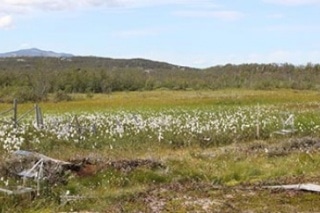Oct 17 2019
With the constant increase in global temperatures, there seems to be a rapid melting of permafrost in the Arctic regions. Mercury trapped in the frozen ground is currently entering into the surrounding water bodies, air, and soil in different forms.
 The fully thawed fens in the Arctic Circle in Abisko, Sweden where UNH researchers found higher levels of methylmercury, a neurotoxin that could be harmful to wildlife, fishing industry, and people. (Image credit: Florencia Fahnestock/UNH)
The fully thawed fens in the Arctic Circle in Abisko, Sweden where UNH researchers found higher levels of methylmercury, a neurotoxin that could be harmful to wildlife, fishing industry, and people. (Image credit: Florencia Fahnestock/UNH)
Scientists from the University of New Hampshire have found that this process can lead to a significant conversion of the mercury into more mobile and potentially harmful forms, thereby leading to environmental problems and health concerns for the fishing industry, wildlife, and people in the Arctic and beyond.
In a study recently reported in Geochemical Perspectives Letters, researchers investigated mercury reallocation—the movement from already frozen soils into the surrounding areas—north of the Arctic Circle in Abisko, Sweden.
They discovered that when the physical features of a land change because of warming temperatures, there is a considerable increase in the methylmercury levels. Methylmercury is a neurotoxin. The greater the methylmercury levels, the greater the cascade of effects.
Our research suggests that Arctic wildlife, such as birds and fish, may be at increased risk of exposure to higher levels of methylmercury that could ultimately impact their reproduction and populations.
Florencia Fahnestock, Study Lead Author and Doctoral Candidate in Earth Sciences, University of New Hampshire
Fahnestock continued, “It also has the potential to impact indigenous people if they are eating methylmercury-contaminated wildlife, and possibly the fishing industry, if the mercury is flushed out of the watershed into the ocean.”
The research widely focused on how climate change causes landscapes to change and hence assist methylmercury production. The researchers considered the “total mercury”—all varied forms of mercury, including gaseous, solid, and methyl—and how it transforms, together with the thawing landscapes, into the more toxic methylmercury, which could be more easily consumed by animals.
Three different landscapes were analyzed for the evolution of the mercury and microorganisms along these landscapes to find out how these changes take place. The researchers estimated palsa, or frozen permafrost, the semi-thawed region often called a bog, and the fen, a saturated landscape filled with completely thawed peat and flowing water.
Analyzing water, air, and soil for methylmercury, the scientists discovered that the fens contained considerably higher methylmercury concentrations than the other landscapes. Fahnestock described that permafrost contained mercury but not methylated. Only when it reaches the watery fens, the lack of oxygen in the sediments is favorable for the conversion of mercury into methylmercury.
We don’t have a good handle on how the mercury gets into terrestrial food webs; it may depend on where land-based animals graze. Plants growing in some of these thawing environments could be laden with mercury.
Julie Bryce, Professor of Geochemistry, University of New Hampshire
Mercury is not only naturally released into the air from forest fires, volcanoes, and weathering of rocks but also from gold mining and fossil fuels. By observing the landscape changes in the Arctic, scientists demonstrated that such methylmercury production and mercury migration could occur in other regions.
During thaw, the mercury discharges and is carried by wind and water—usually far off from its primary source. When it is converted into methylmercury upon discharge or while being transported, it can enter into the food chain, through birds, fish, and wildlife, and the strength increases as it advances up the food chain. This makes mercury a potential public health concern.
The University of New Hampshire motivates innovation and changes lives in the state, nation, and the world. Over 16,000 students from all 50 states and 71 countries become involved in an award-winning faculty in top-ranked programs in engineering, business, health and human services, law, liberal arts, and the sciences across more than 200 study programs.
Being one of the highest performing research universities in the nation, UNH collaborates with NOAA, NASA, NSF, and NIH and obtains more than $110 million in competitive external funding each year to additionally investigate and define the frontiers of land, space, and sea.